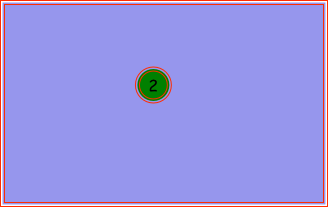Back


New York City. Orbs 1 & 2 have each some p and some q where p is momentum and q is location. Quantum Mechanics (Bohr-Heisenberg) tells us that we can’t measure p and q exactly at the same time for either 1 or 2, but we can measure exactly the sum of p1 and p2 and the difference of q1 and q2. Click the bird  for more detail.
for more detail.
So we find: p = p1 + p2 and q = q1 - q2.






After an interaction orb 2 bounces way off to London while orb 1 remains in the NYC area. Einstein (Podolsky and Rosen) said, Hey, QM (Bohr and Heisenberg), you tell us that we can’t measure p & q exactly at the same time for a given particle, but Yes We Can ! Look – first we measure the new p1 for the big red orb in NYC. Then since momentum is conserved, we know that p2, for the green orb now in London, must = p - p1, the new p1, measured after the boom. AND we can measure the new q1 for the red guy (which, OK, does mess up our measurement before of p1, but that’s not what we’re after) and so we know exactly the new q2 for our green orb in London: q2 = q - q1, the new, measured q1 after the boom. So we can too measure exactly the p & q for a particle at the same time !
What’s wrong with this? Well, the QM people say that by measuring q1 we disturbed p1, and that would disturb p2 down in London. It would have to if we are going to keep the Heisenberg uncertainty principle.
BUT NO ! How can measuring something up here in New York change something down in London??? We determined the new p values before we measured the new q value. For p2 to change now would require spooky action at a distance !  For one thing to make a change in another thing, there has to be a chain of connecting events going from the first to the second. That’s called local causation. You are talking about non-local causation, and that’s impossible.
For one thing to make a change in another thing, there has to be a chain of connecting events going from the first to the second. That’s called local causation. You are talking about non-local causation, and that’s impossible.

Now as Pagels writes, “For over thirty years physicists debated the conclusions of the EPR article.” This means that there is something going on here that is more tricky than it looks at first. Try Googling EPR Paradox and you’ll see.
Here is how Pagels summarizes where we are in this famous paper: “The argument [of EPR] assumes that properties of particle 2 such as its position and momentum in London have objective existence without actually measuring them. The EPR team deduced these properties assuming they had objective significance purely by measurements on particle 1. They then concluded that if quantum theory was right there had to be action-at-a-distance. This conclusion of EPR is sound.” (My emphasis.)
Notice that EPR were arguing on the assumption that, of course, there could not be action at a distance. Theirs was a sort of argumentum ad absurdum. If QM was right, then their deduction that the p & q of orb 2 in London were such and such, was wrong. And that would mean that their measurements in New York had actually altered the reality for orb 2 in London just by making a measurement in New York. That would be a violation of the strictest tenet of causality, that it had to be local, that things had to bump into each other from cause all the way over to effect in order to get an effect. You can’t have action at a distance. It seems that EPR only wanted Bohr-Heisenberg to concede that their QM was missing something; it was incomplete; it didn’t cover this case.
The actual outcome of this famous debate is quite extraordinary. Here is what Pagels says, but note that he was writing in 1982, before the coup de grace was actually given:
“But there is an alternative interpretation of this experiment — the Copenhagen interpretation, which denies the objectivity of the world without actually measuring it. Bohr, who promoted this view, would maintain that the position and momentum of particle 2 have no objective meaning until they are directly measured. If such measurements are carried out they will obey the Heisenberg uncertainty relations in agreement with the quantum theory. Then one avoids the conclusion of action-at-a-distance — instantaneous nonlocal interactions.  Einstein, in opposition to Bohr, could never accept the idea of an observer-created reality. Instead he showed that if reality was objective and quantum theory complete, then there had to be nonlocal effects. Since violating causality is so repugnant, Einstein concluded quantum theory was incomplete.” (164-165)
Einstein, in opposition to Bohr, could never accept the idea of an observer-created reality. Instead he showed that if reality was objective and quantum theory complete, then there had to be nonlocal effects. Since violating causality is so repugnant, Einstein concluded quantum theory was incomplete.” (164-165)
The coup-de-grace unknown to Pagels was delivered by Alain Aspect in an experiment published in 1982, the same year Pagels’ book was published. Prior to 1982 came the extraordinary combination of math and physics called Bell’s Theorem in 1964, which Pagels develops at length. John Bell used mathematics to show that if the EPR argument was true, then a certain kind of experiment would give statistical results more than fifty percent of the time. That’s what the Aspect experiments, and now many others, have shown to be false. If false, then EPR is false, and then QM is true.
This is where we are today. Of course, there are, inevitably, several different interpretations of QM. The standard one is still the Bohr one, the Copenhagen Interpretation. See The Ghost in the Atom: A Discussion of the Mysteries of Quantum Physics (1986; 2000) edited by P C W Davies and J R Brown for interviews with eight of the then most significant theorists in this field on just what to make of this “spooky action at a distance.” Those interviewed include Aspect and Bell as well as John Wheeler and David Bohm.
The core problem that arises in all the discussions is how to deal with the fact that the observer is somehow inextricably involved in measuring reality.
Here is how Brian Green describes the results of Aspect’s experiment, writing in The Fabric of the Cosmos (2004) on page 113 of the paper cover edition, his emphasis: “But, and this is the crucial point, when Aspect examined data from a large number of runs of the experiment … he found that the detectors did not agree more than 50 percent of the time.
“This is an earth-shattering result. This is the kind of result that should take your breath away. But just in case it hasn’t, let me explain further. Aspect’s results show that Einstein, Podolsky, and Rosen were proven by experiment – not by theory, not by pondering, but by nature – to be wrong. And that means there has to be something wrong with the reasoning EPR used to conclude that particles possess definite values for features … for which definite values are forbidden by the uncertainty principle.”
In other words, there IS spooky action at a distance. Non-local causality is real. And that is what is so loosely bandied about by most of us today as “nonlocality.” It means that cause and effect are (sometimes at least) no longer what we always thought they were. It means that doing something to a particle here can instantly affect another particle over there, well beyond the reach of anything traveling at the speed of light, and without there being any intervening or connecting causal links.
I quote Green again:
“Einstein, Podolsky, and Rosen set out to show that quantum mechanics provides an incomplete description of the universe. Half a century later, theoretical insights and experimental results inspired by their work require us to turn their analysis on its head and conclude that the most basic, intuitively reasonable, classically sensible part of their reasoning is wrong: the universe is not local. The outcome of what you do at one place can be linked with what happens at another place, even if nothing travels between the two locations – even if there isn’t enough time for anything to complete the journey between the two locations. Einstein’s, Podolsky’s, and Rosen’s intuitively pleasing suggestion that such long-range correlations arise merely because particles have definite, preexisting, correlated properties is ruled out by the data. That’s what makes this all so shocking.”
I notice that Green does not, but Pagels does, add that “the Copenhagen interpretation … denies the objectivity of the world without actually measuring it.” (I’m quoting from Pagels in the column to the left of this.) At this point is is appropriate to drop in the usual but apocryphal quote from Richard Feynman: “If you think you understand quantum mechanics, you don’t understand quantum mechanics.”


Einstein’s very famous complaint about QM. His words.
We avoid action-at-a-distance as long as we deny “the objectivity of the world without actually measuring it.” Today, people rather casually speak of “nonlocality” and “entanglement” as if we can somehow easily have both our ordinary sense of the world and this other one where we do get mysterious action at a distance and (to use another Einstein counter example) a moon that doesn’t exist unless we look at it. But Bohr was saying we can’t have it both ways. This is not easy. Remember Lao Tzu: “The way that can be known is not the way.”


 for more detail.
for more detail.





 For one thing to make a change in another thing, there has to be a chain of connecting events going from the first to the second. That’s called local causation. You are talking about non-local causation, and that’s impossible.
For one thing to make a change in another thing, there has to be a chain of connecting events going from the first to the second. That’s called local causation. You are talking about non-local causation, and that’s impossible.
 Einstein, in opposition to Bohr, could never accept the idea of an observer-created reality. Instead he showed that if reality was objective and quantum theory complete, then there had to be nonlocal effects. Since violating causality is so repugnant, Einstein concluded quantum theory was incomplete.” (164-165)
Einstein, in opposition to Bohr, could never accept the idea of an observer-created reality. Instead he showed that if reality was objective and quantum theory complete, then there had to be nonlocal effects. Since violating causality is so repugnant, Einstein concluded quantum theory was incomplete.” (164-165)



